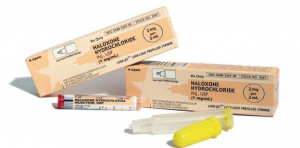 All patients on long-term opioid treatment should be co-prescribed the opioid overdose antidote naloxone, even if they are not considered to be at high risk of an opioid overdose, according to the director of the University of New Mexico Pain Center.
All patients on long-term opioid treatment should be co-prescribed the opioid overdose antidote naloxone, even if they are not considered to be at high risk of an opioid overdose, according to the director of the University of New Mexico Pain Center.
Patients on long-term opioids should be co-prescribed naloxone because the risk of opioid overdose can change quickly, says Joanna Katzman, M.D. “You never know when someone will go from low risk to medium risk to high risk, especially in the chronic pain population. A person can be on a stable dose of opiates and then develop a condition that depresses breathing, such as pneumonia, sleep apnea or a fever. Because opiates also depress breathing, suddenly they are at risk.” Or a person may go to the hospital and receive a higher dose of opiates from a physician than what they are already on, increasing their risk of an overdose, Dr. Katzman noted.
“We think naloxone should be supplied by clinicians liberally, and also should be in the hands of law enforcement and emergency medical services,” she said. She added that many patients who die of an unintentional opiate overdose get the drugs from a family member or friend instead of their health care provider.
Dr. Katzman published a study earlier this year in the journal Substance Abuse that included 164 patients taking long-term opioids for non-cancer pain, who were also prescribed naloxone. They and their families were educated about the risks and signs of an opioid overdose. They were provided naloxone rescue kits, and family members were shown how to use it. No overdoses occurred among the patients in the study.
“We showed we can teach patients and family how to use opiates safely and how to use naloxone,” Dr. Katzman said. “We also found patients did not think we considered them drug users because we were giving them naloxone. They appreciated that we were caring for them more safely.”
According to guidelines for prescribing opioids for chronic pain, issued earlier this year by the Centers for Disease Control and Prevention, most experts agreed that clinicians should consider offering naloxone when prescribing opioids to patients at increased risk for overdose, including patients with a history of overdose, patients with a history of substance use disorder, patients taking benzodiazepines with opioids, patients at risk for returning to a high dose to which they are no longer tolerant (such as patients recently released from prison), and patients taking higher dosages of opioids. Dr. Katzman says those recommendations should go a step further, by providing naloxone to all patients on chronic opioid therapy, regardless of whether they are considered high risk.
Naloxone is becoming easier to buy around the country. Most states have passed laws allowing people to buy naloxone without a prescription. Drugstores and other retailers are also making it more easily available. Until recently, naloxone, sold as Narcan, was available mostly through clinics, hospitals or paramedics and other first responders.
Dr. Katzman is now conducting a study of patients enrolled at the University of New Mexico’s Addiction Clinic who have opioid substance use disorder. The patients, who are being treated with either methadone or buprenorphine, are also given a handheld device called Evzio that delivers a single dose of naloxone. “We’ve enrolled almost 300 patients so far, and we already have seen that many lives have been saved so far,” she said. Dr. Katzman hopes to publish the results soon.
People being treated for opioid addiction are at greatest risk of overdose in the first days after they begin treatment with medication-assisted treatment. Dr. Katzman said many studies have shown that co-prescribing naloxone with opioids does not increase the misuse of prescription opioids or heroin. “Some people think that by handing out naloxone, it will encourage people to use more drugs. Many studies have disproved that. I think opioid substance use disorder treatment centers should be required to co-prescribe ‘take-home’ naloxone in their programs.”
Published
December 2016
 Get Support
Get Support
